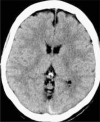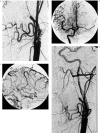Dural Sinus Thrombosis Complicated with Heparin Induced Thrombocytopenia and Thrombosis (HITT)
- PMID: 20594517
- PMCID: PMC3572528
- DOI: 10.1177/159101990200800114
Dural Sinus Thrombosis Complicated with Heparin Induced Thrombocytopenia and Thrombosis (HITT)
Abstract
A case of dural sinus thrombosis complicated with heparin induced thrombocytopenia and thrombosis (HITT) is presented. Interventional neuroradiologic procedures have potential risks of this devastating complication that is related with heparin. Clinical features and pathophysiologic mechanisms of HITT are discussed.
Figures



References
-
- Walenga JM, Bick RL. Heparin-induced thrombocytopenia, paradoxical thromboembolism, and other side effects of heparin therapy. Med Clin North Am. 1998;82:635–658. - PubMed
-
- Warkentin TE, Levine MN, et al. Heparin-induced thrombocytopenia in patients treated with low-molecular-weight heparin or unfractionated heparin. N Engl J Med. 1995;332:1330–1335. - PubMed
-
- Jackson MR, Gillespie DL, et al. The incidence of heparin-induced antibodies in patients undergoing vascular surgery: a prospective study. J Vasc Surg. 1998;28:439–444. - PubMed
-
- Kappers-Klunne MC, Boon DM, et al. Heparin-induced thrombocytopenia and thrombosis: a prospective analysis of the incidence in patients with heart and cerebrovascular diseases. Br J Haematol. 1997;96:442–446. - PubMed
-
- van Sambeek MR, Segeren CM, et al. Endovascular repair of an extracranial internal carotid artery aneurysm complicated by heparin-induced thrombocytopenia and thrombosis. J Endovasc Ther. 2000;7:353–358. - PubMed
LinkOut - more resources
Full Text Sources

